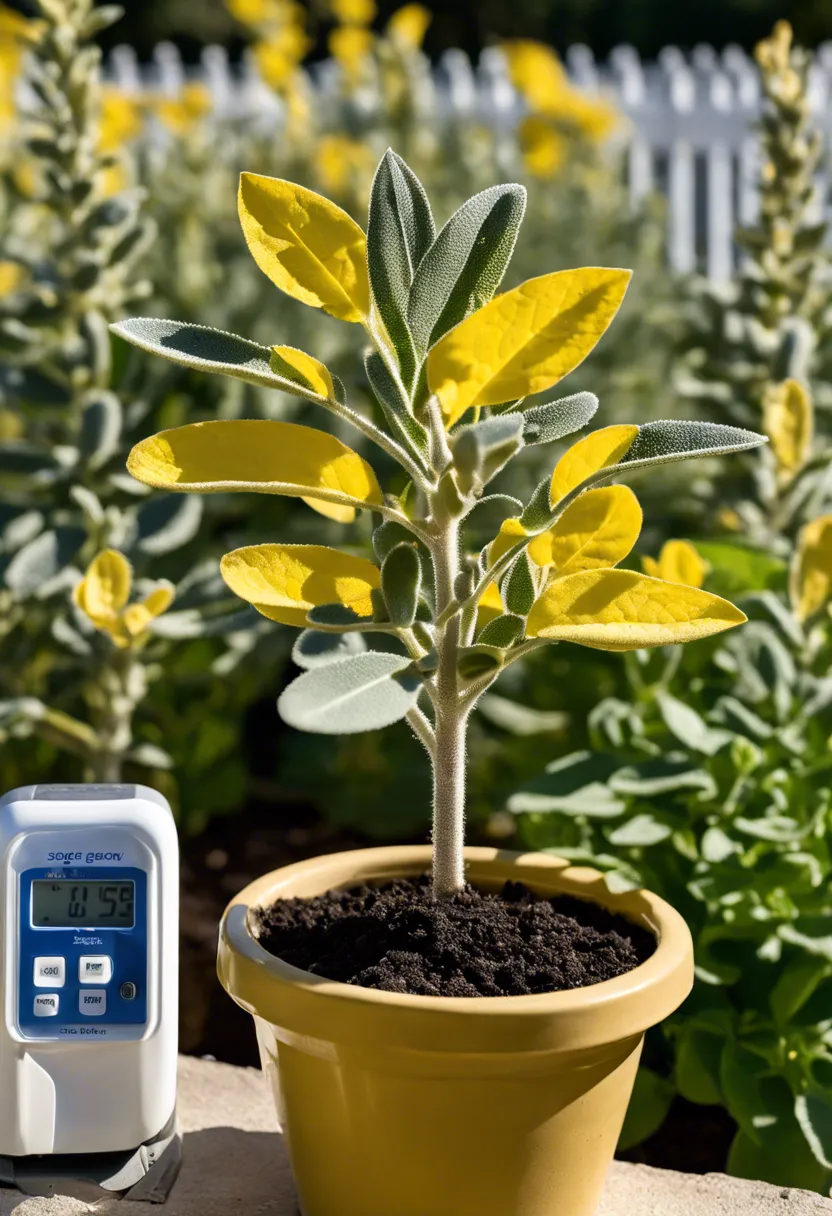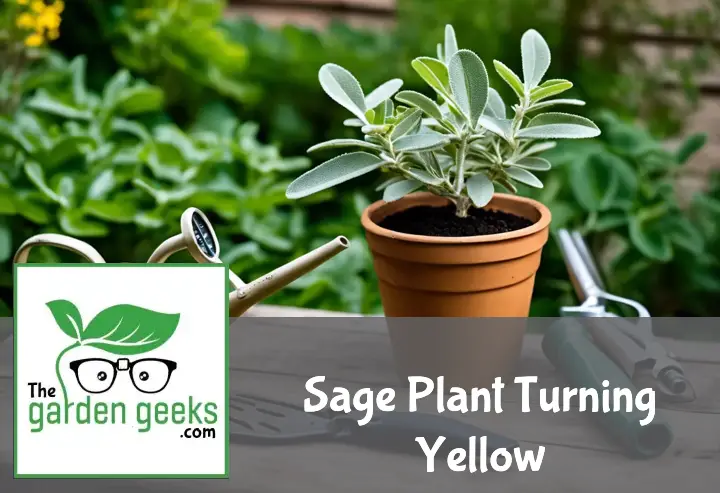You know that sinking feeling when you see your beloved Sage Plant Turning Yellow? It’s like watching a dear friend fall ill. You’re left wondering, “What did I do wrong?” and “How can I fix this?”
In the world of gardening, yellowing leaves are often a sign of distress. But don’t panic just yet! There could be several reasons why your sage plant is turning yellow – from overwatering to nutrient deficiency.
Keep reading about Sage Plant Turning Yellow, and let’s diagnose the problem together. After all, every good gardener knows that understanding the issue is the first step towards finding a solution.
Key Takeaways
- Your sage plant turning yellow could be due to overwatering, lack of sunlight, or nutrient deficiency.
- To fix it, first check the watering schedule. Sage likes dry soil, so water it less frequently.
- Next, ensure your sage is getting enough sun. It needs full sun exposure for at least 6 hours a day.
- Lastly, if the problem persists, consider adding a balanced fertilizer to provide essential nutrients.
- Remember: too much love can kill your sage! So don’t overdo it with water or fertilizer.

Understanding Sage Plant
Let’s dive into the world of sage, a plant that’s not just for Thanksgiving stuffing. Understanding its needs and common issues is key to keeping it from turning yellow.
What is a Sage Plant?
Sage, with its soft, gray-green leaves and woody stems, is more than just a culinary herb. It’s a botanical powerhouse used in cooking for its earthy flavor and in medicine for its health benefits. Sage botanical description tells us it belongs to the mint family, making it a cousin to other herbs like oregano and thyme. Its culinary uses of sage are vast, adding depth to dishes from butternut squash soup to sausage stuffing. Beyond the kitchen, medicinal benefits of sage include aiding digestion and improving memory. Culturally, sage holds significant value; it has been used in cleansing rituals and was highly regarded in ancient Rome as a symbol of wisdom.
Ideal Growing Conditions for Sage Plant
To cultivate a thriving sage plant, start with well-draining soil; this herb despises wet feet! Optimal soil for sage should be sandy or loamy and slightly alkaline. When it comes to sunlight, more is better. Ensure your sage gets at least 6-8 hours of direct sunlight daily; this sunlight requirement for sage helps develop those aromatic oils that make the herb so desirable. Watering needs are modest – let the soil dry out between watering sessions to avoid root rot. As for temperature, sage prefers it on the warmer side but can tolerate cool weather down to about 15°F once established.
Common Problems with Sage Plants
Even with perfect care, your sage might run into some trouble. Pests like spider mites and aphids find sage as tasty as we do. If you notice fine webbing or sticky leaves, you’ve got company! Moving on to diseases – powdery mildew and root rot are common foes resulting from too much moisture around your plant’s base or poor air circulation. Overzealous watering can lead your sage plant turning yellow, signaling distress; whereas under-watering leads to droopy leaves begging for a drink. Lastly, nutrient deficiencies manifest as pale or spotted leaves; ensuring your soil has balanced nutrients can prevent these issues.
Why is Your Sage Plant Turning Yellow?
Discovering your sage plant turning yellow can be disheartening. But don’t worry, we’re here to dissect the common culprits like overwatering, nutrient deficiency, and pesky invaders that could be causing this leafy dilemma.
Overwatering and Root Rot
Ever heard of too much love? Well, your sage plant might be a victim of it through overwatering. When you drench those roots more than they can drink up, it leads to soggy soil conditions perfect for root rot. This nasty condition hampers the plant’s ability to absorb nutrients and water, leading to yellow leaves on sage. Signs include wilted, yellow or brown leaves, and a mushy base.
To prevent this watery grave, ensure your sage is planted in well-draining soil and cut back on the H2O. A good rule of thumb is to let the top inch of soil dry out before giving it another drink. If you suspect root rot has already set in, all is not lost! Gently remove your plant from its pot and trim away any dark, mushy roots before repotting in fresh soil. Improving soil drainage and adjusting your watering schedule for sage can bring your plant back from the brink.
Nutrient Deficiency
Yellow leaves can also scream “Feed me!” if your sage lacks essential nutrients. Common culprits include nitrogen and iron deficiencies which manifest as pale or yellow leaves while veins remain green. It’s a classic case of nutrient deficiency symptoms that demands immediate action.
First off, identify the deficiency by observing the symptoms closely. For nitrogen-starved plants, consider incorporating a balanced fertilizer into your sage plant care routine. Iron supplements can help those lacking in that department regain their vibrant green color. Remember, moderation is key; over-fertilizing can lead to other issues.
Disease and Pests
Lastly, diseases and pests are notorious for turning sage plants yellow with their unwelcome presence. Powdery mildew and downy mildew are common fungal foes that leave a dusty or oily residue on leaves before they turn yellow and drop.
On the pest side of things, watch out for aphids and spider mites sucking the life out of your sage leaves causing them to yellow and weaken. Identifying these problems early is crucial; look for tiny bugs under leaves or webbing between branches.
For diseases, organic fungicides or proper air circulation around plants can work wonders in prevention. As for pests, introducing natural predators like ladybugs or applying organic pesticides for herbs can keep these critters at bay without harming your plant or the environment.
By understanding these common issues behind sage plant turning yellow, you’re well-equipped to diagnose and treat your herbal buddy back to health!



Step-by-Step: How to Revive a Yellowing Sage Plant


So, your sage plant has decided to show its true colors, and unfortunately, it’s yellow. Not the vibrant green you were hoping for. Fear not! We’re about to embark on a rescue mission to bring back that lush greenery. It’s like being a plant doctor, but without the need for a medical degree.
-
Assess the situation: First things first, take a good look at your sage plant. Is it just one or two leaves turning yellow, or is it more like a yellow party? Knowing the extent of the “yellowness” will help you figure out how serious the problem is.
-
Check the soil: Stick your finger into the soil about an inch deep. If it feels like you’ve just dipped your finger into a waterlogged sponge, then overwatering might be the culprit. On the flip side, if it feels as dry as the Sahara Desert, then underwatering could be to blame.
-
Adjust watering habits: Based on your soil check, it’s time to tweak how much water you’re giving your sage plant. If it’s too wet, let the soil dry out before watering again. For dry soil, give your plant a nice drink of water but don’t go overboard; think quenching thirst, not creating a flood.
-
Evaluate sunlight exposure: Sage loves sunlight like teenagers love their smartphones. Ensure your plant is getting at least 6 to 8 hours of direct sunlight daily. If it’s not getting enough light, consider moving it to a sunnier spot.
-
Inspect for pests: Get up close and personal with your sage plant and look for any uninvited guests like aphids or spider mites. These little critters can cause yellowing leaves too! If you find any pests, gently wash them off with water or use an organic insecticide.
-
Prune affected leaves: Sometimes, you just have to let go… of yellow leaves that is! Pruning away yellow or dead leaves can help redirect energy back towards healthy growth.
-
Feed your plant: A hungry sage is a sad sage. Feed your plant with a balanced liquid fertilizer every 4-6 weeks during its growing season (spring through fall). This will provide essential nutrients and encourage vibrant green growth.
-
Monitor progress: After taking these steps, keep an eye on your sage plant over the next few weeks. Improvement might not happen overnight but watch for signs of new growth and lessening yellow tones in existing foliage.
By following these steps diligently, you’ll be well on your way to reviving that once-yellowing sage plant back to its glorious green self! Remember patience and consistency are key; plants don’t operate on human schedules but with some TLC they’ll bounce back.
Preventive Measures to Keep Your Sage Plant Healthy
Keeping your sage plant vibrant and green doesn’t have to be a mystery. By following these straightforward tips, you can prevent the dreaded sage plant turning yellow and ensure your herb thrives. Here’s how:
-
Optimal watering practices for sage: Sage plants dislike wet feet. Ensure you’re allowing the soil to dry out between waterings. Overwatering is a common misstep that leads to yellow leaves.
-
Soil requirements for healthy sage: These plants love well-draining soil. Mix in some sand or perlite to improve drainage, especially if you’re growing sage in pots.
-
Sun exposure for sage plants: Sage adores the sun! Make sure it gets at least 6 to 8 hours of direct sunlight daily. Too little light can weaken the plant, leading to yellowing leaves.
-
Avoiding over-fertilization: More food isn’t always better. Use a balanced, slow-release fertilizer sparingly to prevent nutrient burn, which can cause leaf discoloration.
-
Disease prevention in herbs: Keep an eye out for signs of disease or pests and act swiftly. Healthy plants are less susceptible, so maintaining overall vigor is key.
-
Proper drainage for potted sage: Ensure your pots have adequate drainage holes. Waterlogged roots are a fast track to health issues.
-
Seasonal care tips for sage: Adjust your care with the seasons—less water in winter, more in summer, and protect from extreme cold.
-
Pruning techniques for sage health: Regular pruning not only keeps your sage bushy and compact but also encourages new growth and prevents disease by improving air circulation around the plant.
By incorporating these practices into your regular sage plant care routine, you’ll be well on your way to preventing yellow leaves and enjoying a lush, healthy herb garden year-round. Remember, consistency is key when it comes to nurturing plants—your sage will thank you for it!


To Wrap Up
In the end, it’s all about understanding and responding to your sage plant’s needs. If your Sage Plant Turning Yellow, it could be due to overwatering, poor soil conditions, or even a pest attack.
But don’t fret! With the right care and attention, you can nurse your sage back to its vibrant green glory. Remember – moderation is key when it comes to watering and sunlight exposure.
Now that you’re armed with this knowledge, go forth and save your sage! Your garden will thank you for it.


